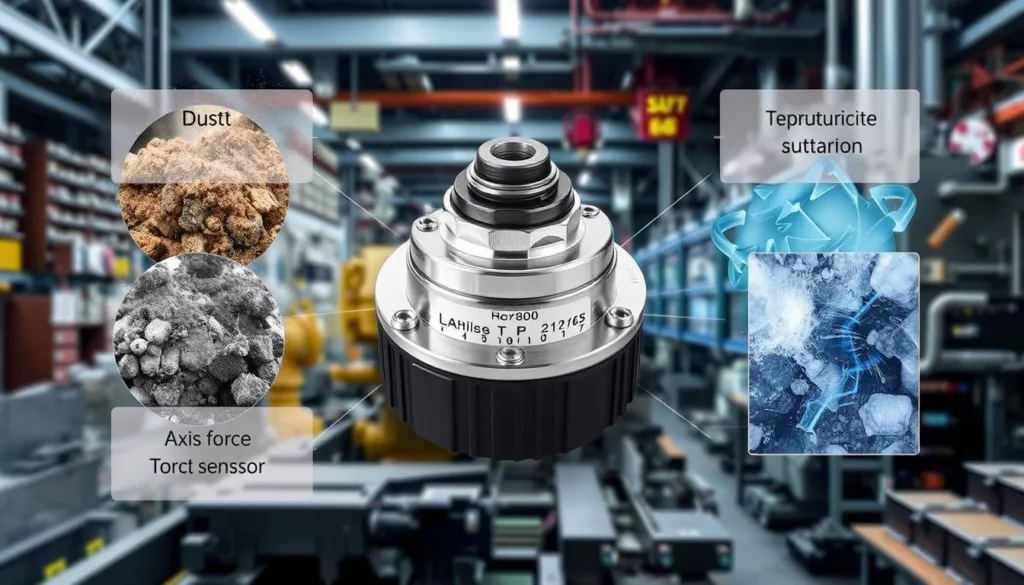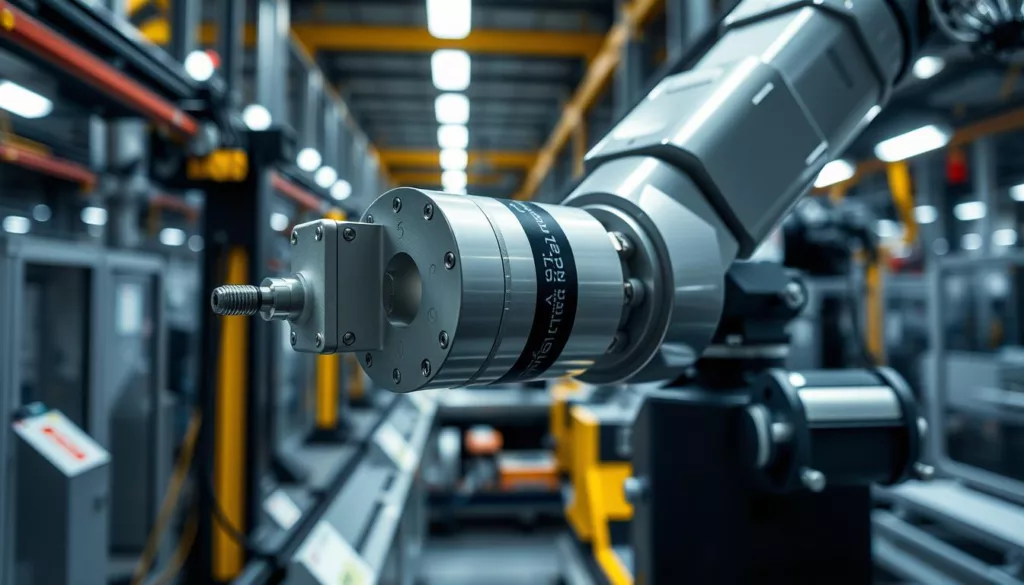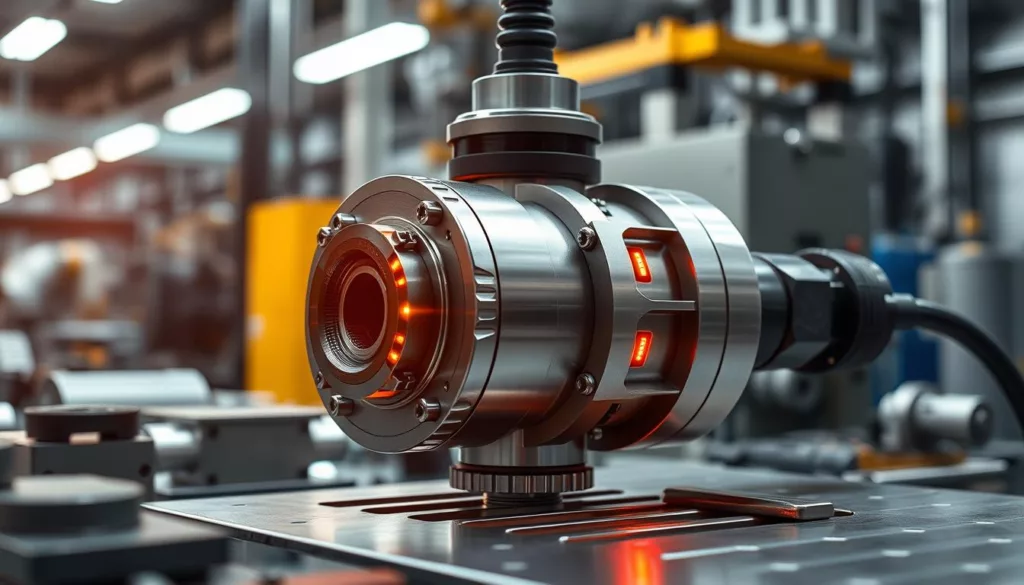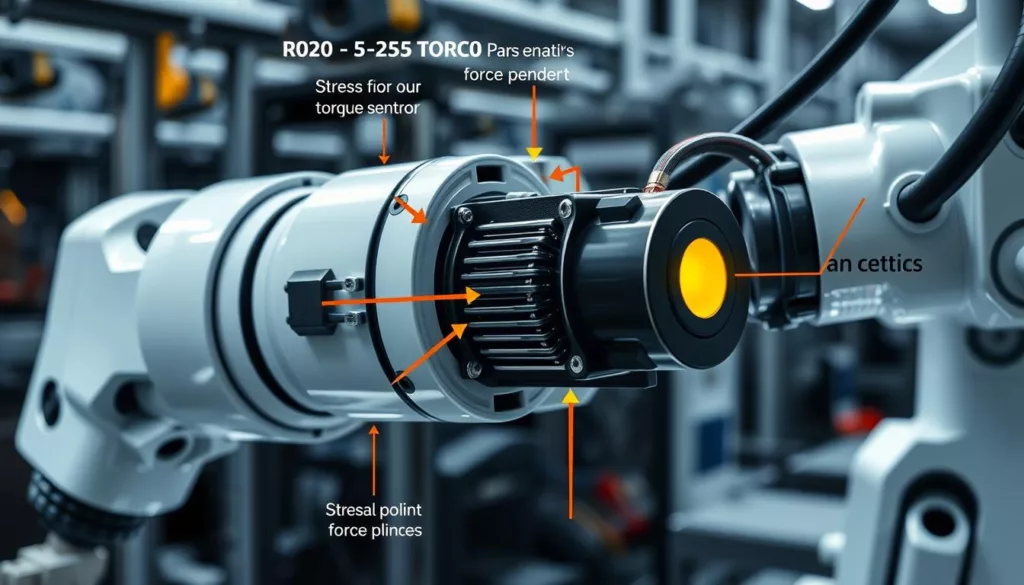The robotics and automation fields are growing fast. This means we need to measure force and torque more accurately. 6 axis force torque sensors are key for many tasks, from making things in factories to helping in surgery and research.
Finding the right sensor can be hard. But don’t worry, this guide will help you. We’ll cover what to look for when picking the best 6 axis force torque sensor for you.
Key Takeaways
- Understand the fundamental principles of force and torque measurement for 6 axis sensors
- Evaluate the key technical specifications, including measurement range, resolution, and accuracy
- Consider environmental factors and operating conditions that may impact sensor performance
- Assess integration requirements, such as hardware interfaces and software capabilities
- Explore industry-specific applications and specialized requirements
Understanding Force Torque Sensor Fundamentals
At the heart of robotic and industrial systems is the force torque sensor. These tools measure forces and moments with high precision. This lets systems control and monitor themselves better. Knowing how they work and what they’re made of is key.
Basic Principles of Force and Torque Measurement
Force torque sensors use physics to measure forces and moments. They have special sensors that feel tiny changes in shape caused by forces. This lets them show how accurate and strong these sensors are.
Components of 6-Axis Sensors
A 6-axis force torque sensor has a few main parts:
- Sensing elements (like strain gauges or piezoelectric crystals)
- Signal conditioning circuitry
- A microcontroller for processing data
- Communication interfaces (like digital, analog, or wireless)
Measurement Axes Explained
These sensors measure forces and moments in six directions. They track three linear forces (Fx, Fy, Fz) and three rotational moments (Tx, Ty, Tz). This gives a full picture of a system’s dynamics, helping with better control and optimization.
“The accuracy and robustness of force torque sensors are key for reliable performance in robotics and industry.”
How to Choose the Right 6 Axis Force Torque Sensor
Choosing the right 6 axis force torque sensor is key for your application. The right sensor boosts your system’s performance and reliability. It’s important to carefully look at your needs.
We’ve made a step-by-step guide to help you pick the right sensor. It covers the main things to think about:
- Application Requirements: Know how you plan to use the force torque sensor. Think about the measurements, forces, and torques you’ll need. This helps you find sensors that fit your needs.
- Environmental Conditions: Think about where the sensor will be used. Consider temperature, humidity, and if there are dangerous materials around. A sensor that can handle these conditions is important for lasting performance.
- Integration Considerations: Look at how the sensor will fit with your setup. Check its size, mounting options, and how it communicates. A smooth integration makes setup easier.
By thinking about these points, you can find the 6 axis force torque sensor that fits your force torque sensor applications and force torque sensor integration needs. This will make your system work better and more efficiently.
“Choosing the right 6 axis force torque sensor is key for accurate and reliable measurements. It’s important for your project’s success.”
But, choosing the right sensor is just the start. You also need to keep it calibrated and maintained. This keeps its accuracy and reliability over time. By looking at all these factors, you can confidently pick the 6 axis force torque sensor that meets your needs and adds value to your organization.
Key Technical Specifications to Consider
Choosing a 6-axis force torque sensor requires knowing the key specs. These specs affect how well the sensor works and if it fits your needs. Let’s look at the important factors to think about:
Measurement Range Requirements
The sensor’s range shows the forces and torques it can measure. Make sure the range fits the loads in your project. If it doesn’t, you might get wrong readings or damage the sensor.
Resolution and Accuracy Specifications
Resolution is the smallest change the sensor can spot. Accuracy is how close the sensor’s reading is to the real value. You want high resolution and accuracy for precise data. Check the force torque sensor specifications to see if they match your needs.
Sampling Rate Considerations
The sampling rate is how often the sensor takes measurements. It’s key for fast-changing forces or torques. A higher rate means more data, giving a clearer picture of the forces.
Looking closely at the force torque sensor accuracy and other specs helps pick the right sensor. This ensures it meets your project’s needs, giving you reliable and accurate force and torque data.
Environmental Factors and Operating Conditions
When picking a 6-axis force torque sensor, think about the environment it will face. These conditions can greatly affect how well the sensor works and lasts.
Temperature is a key factor. The sensor needs to handle the temperature of its use area. This could be very hot, very cold, or changing a lot. Some sensors use special algorithms to stay accurate in different temperatures.
Humidity is also important. The sensor should work well in both dry and wet conditions. Look for sensors with high IP ratings to see how well they protect against dust and water.
Electromagnetic interference (EMI) can also mess with sensor performance. Sensors with strong shielding and noise reduction can handle EMI better. This ensures they give accurate readings, even in noisy places.
| Environmental Factor | Sensor Requirement | Potential Impact |
|---|---|---|
| Temperature | Wide operating temperature range, thermal compensation | Measurement accuracy, sensor stability |
| Humidity | High ingress protection (IP) rating | Sensor reliability, corrosion resistance |
| Electromagnetic Interference (EMI) | Robust shielding, noise suppression | Measurement stability, signal integrity |
Think about your application’s environment and conditions carefully. This way, you can find a 6-axis force torque sensor that’s right for you. It will have the force torque sensor robustness and force torque sensor applications you need for reliable and lasting performance.
Integration Requirements and Compatibility
When you add a 6-axis force torque sensor to your system, think about the hardware and software needs. Look at the interfaces, software support, and communication protocols. This makes sure the sensor fits well with your current setup.
Hardware Interface Options
6-axis force torque sensors come with different ways to connect, like:
- Analog (voltage or current) outputs
- Digital interfaces such as Ethernet, USB, or serial communication
- Fieldbus protocols like CANbus or EtherCAT
Make sure these options match your current gear and systems. This helps with a smooth force torque sensor integration process.
Software Integration Capabilities
Choose a 6-axis force torque sensor with good software support, including:
- SDK or API for common programming languages and platforms
- Works well with industrial automation software
- Easy to use with data acquisition and processing tools
This makes force torque sensor data acquisition easier. You can add the sensor data to your software without trouble.
Communication Protocols
| Communication Protocol | Advantages | Typical Applications |
|---|---|---|
| Ethernet | Fast data transfer, fits well with IT networks | Industrial automation, robotic control, remote monitoring |
| EtherCAT | Fast, reliable data, works well for real-time needs | Motion control, machine automation, robotics |
| CANbus | Strong, dependable, used a lot in industry | Factory automation, machinery control, automotive systems |
Check the communication protocols the 6-axis force torque sensor supports. Make sure they match your control and monitoring systems.
Industry-Specific Applications and Requirements
Choosing the right 6 axis force torque sensor is key. XJCSENSOR offers advanced sensors for many industries. Each industry has its own needs and conditions.
Robotics Applications
Force torque sensors are vital in robotics. They help with precise measurements of force and torque. This is important for tasks like handling objects and detecting collisions.
Robotic applications need sensors that are accurate and can handle tough environments.
Aerospace and Automotive Testing
The aerospace and automotive fields use 6 axis force torque sensors for testing. They measure structural loads and aerodynamic forces. These sensors must be durable and capture data accurately.
Manufacturing and Quality Control
In manufacturing, sensors are key for quality control and process improvement. They measure forces and torques during assembly and testing. This ensures products are made consistently and efficiently.
“XJCSENSOR’s 6-axis force torque sensors are designed to meet the diverse requirements of various industries, balancing precision, durability, and integration.”
Knowing what your industry needs helps choose the right sensor. This improves performance, boosts efficiency, and fosters innovation.
Calibration and Maintenance Considerations
Keeping your force torque sensors accurate and reliable is key. This ensures you get precise measurements and make smart choices. It’s important to follow the right calibration and maintenance steps to keep your sensors working well for a long time.
Calibration Procedures
Calibration is needed to keep the sensor’s performance steady over time. It involves checking the sensor against a known standard to see if it’s accurate. Following the maker’s calibration guide is vital for keeping your sensor’s accuracy and dependability.
Maintenance Schedules
- Make a maintenance plan based on how often you use the sensor, the environment, and the maker’s advice.
- Check the sensor for damage, wear, or signs of damage that could affect its performance.
- Follow the maker’s cleaning instructions to keep the sensor clean and working well.
Performance Verification
It’s important to check the sensor’s performance regularly. This helps spot any changes or issues. You might do test measurements, compare the sensor’s output to known values, or use special tools to check its accuracy and consistency.
“Proper calibration and maintenance of your force torque sensors is essential for maintaining their accuracy and reliability over time. By following the manufacturer’s recommendations and establishing a regular maintenance routine, you can ensure your sensors continue to provide precise and reliable measurements for your applications.”
By sticking to these best practices for calibration and maintenance, you can make your force torque sensors work their best. This ensures the calibrating force torque sensors and force torque sensor accuracy you need for your projects.
Cost Analysis and ROI Evaluation
Choosing the right 6 axis force torque sensor involves more than just the initial cost. We must look at long-term costs and the return on investment (ROI) too.
The prices of force torque sensor manufacturers differ a lot. This is due to things like sensor complexity, range, accuracy, and customization. Even though top sensors cost more upfront, their better performance and longer life can make them worth it. Looking at all costs, including maintenance and replacement, helps see the sensor’s true value.
| Cost Factor | Considerations |
|---|---|
| Initial Investment | Sensor price, installation, and integration costs |
| Operational Expenses | Maintenance, calibration, and energy consumption |
| Potential ROI | Improved productivity, quality control, and safety |
To figure out the ROI of a 6 axis force torque sensor, we need to look closely at how it will help. Things like better efficiency, less waste, and safer work can save money and make more. By thinking about the whole picture, companies can pick the best sensor for their needs.
“The right sensor investment can unlock significant operational and financial benefits for our business.”
Looking at all costs and possible ROI helps make sure the 6 axis force torque sensor fits with the company’s long-term plans. It ensures the investment has a big impact on the company’s finances.
Manufacturer Selection Criteria
Choosing the right force torque sensor manufacturers is key. Look at their reputation, technical support, warranty, and after-sales service. These factors can greatly affect your project’s success. By carefully checking these, you can find a reliable partner for your sensor needs.
Reputation and Support Services
The reputation of the force torque sensor manufacturers matters a lot. Choose companies known for quality and great customer service. Talk to their technical support to see how they handle your needs. A good reputation and skilled support team are vital for your 6 axis force torque sensor to work well.
Warranty and After-Sales Support
Good warranty and after-sales support give you peace of mind. Check the warranty terms, including how long it lasts and what it covers. Also, see if they offer parts, repairs, and maintenance help. A manufacturer that supports their products well is a great partner for your 6 axis force torque sensor.
| Manufacturer | Reputation | Warranty | After-Sales Support |
|---|---|---|---|
| XJCSENSOR | Established industry leader with a reputation for innovation and technical expertise | 5-year complete warranty with quick replacement and repair services | Dedicated technical support team, readily available spare parts, and customized maintenance programs |
| ABC Sensors | Reputable manufacturer with a growing presence in the force torque sensor market | 3-year warranty with limited coverage and extended repair turnaround times | Technical support available via email and phone, but limited on-site assistance and spare parts inventory |
| XYZ Automation | Newcomer to the force torque sensor industry, but with a strong focus on innovation | 2-year warranty with strict exclusions and complex claim process | Limited technical support resources and unpredictable availability of replacement parts |
By looking at the reputation, warranty, and after-sales support of force torque sensor manufacturers, you can make a smart choice. This ensures your 6 axis force torque sensor solution works well for your project.
Common Integration Challenges and Solutions
Adding force torque sensor tech to your projects can be tricky. But, with the right steps, you can beat these hurdles. Let’s look at some common problems and how to solve them for smooth force torque sensor integration and data acquisition.
Signal Processing and Noise Reduction
One big challenge is handling signal processing and cutting down noise. Sensor data can get affected by things like electromagnetic interference and vibrations. To fix this, use advanced signal filtering. This can make your data clearer and more reliable.
Data Interpretation and Visualization
Dealing with lots of force torque sensor data can be tough. Making data easy to understand can help a lot. Use data analytics tools and custom dashboards to turn raw data into useful insights. This way, you can make better decisions based on your data.
Calibration and Validation
It’s key to make sure your force torque sensor system is accurate and reliable. Do thorough calibrations as the maker suggests. Also, check the sensor’s performance often to catch any issues early. This keeps your system working well.
| Integration Challenge | Solution |
|---|---|
| Signal Processing and Noise Reduction | Implement digital filtering techniques, shielding, and grounding strategies to improve signal-to-noise ratio |
| Data Interpretation and Visualization | Develop intuitive data visualization tools and dashboards to transform raw sensor data into actionable insights |
| Calibration and Validation | Follow manufacturer’s guidelines for calibration, and regularly validate sensor performance to maintain accuracy |
By tackling these common issues, you can get the most out of your force torque sensor tech. With the right methods and tools, you can make your applications better. And you’ll get valuable insights from your sensor data.
Conclusion
Choosing the right 6 axis force torque sensor is a big decision. You need to think about technical specs, the environment, and how it will fit into your system. Knowing how these sensors work helps you pick the best one for your needs.
Look at the sensor’s range, resolution, and accuracy. Also, consider the sampling rate and the environment it will work in. Make sure it fits with your system’s hardware, software, and communication. Think about the specific needs of your industry and how to keep the sensor working well.
This guide has shown why picking the right 6 axis force sensor is so important. By looking at all the factors we’ve discussed, you can choose wisely. This choice will help your automation or robotic system work better and more efficiently. Remember, the right sensor is key to getting the control and performance you need.





